Content
Propagating blackberries by cuttings is one of the common ways to increase the number of shrubs on the site. The method can be used by any novice gardener with certain skills and equipment.
Pros of blackberry propagation by cuttings
When breeding a crop, you should use its various parts: rhizome, stem and even a leaf. The vegetative method implies the ability to grow a blackberry from a cuttings. This method allows you to recreate an instance that is identical in characteristics to the parent.
The method does not require large investments and physical efforts. With a successful outcome, cuttings make it possible to quickly propagate the plant on the site.
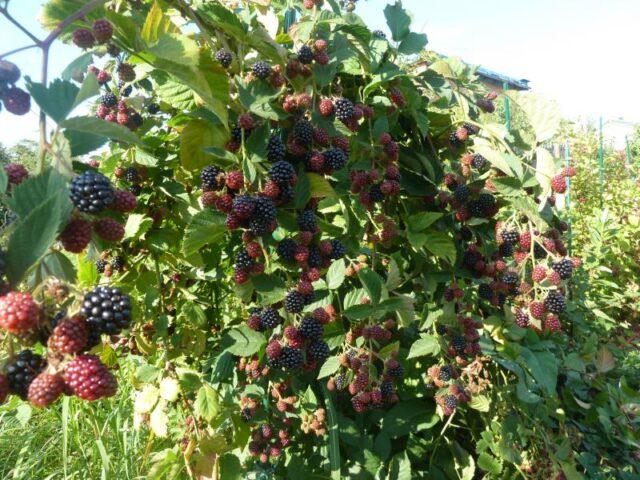
A culture grown from a cuttings has a weak immunity, therefore, it is not recommended to use it during subsequent reproduction.
Features of blackberry cuttings depending on the variety
This breeding method has its own characteristics. It cannot be applied to all varieties of blackberries.
Propagation of a thornless type by cuttings is not recommended. As a result, the gardener will receive a bush with thorns. With lignified or green cuttings in thornless varieties, seedlings often die during such propagation.
Repaired blackberries are capable of bearing fruit twice a year. Cuttings should be carried out in the summer, and the finished seedlings should be transferred to the site in August or September. Young bushes can please with the harvest next year after breeding.
Standard and common blackberries lend themselves very well to lignified shoots. For successful growth and development, the seedling should be properly cared for.
When to harvest cuttings of garden blackberries
There is no specific time frame for the procurement of planting material. Spring propagation by cuttings should be completed before the buds open. The rhizome is separated at a later date. If you need to germinate "green" cuttings, then the optimal time is summer. The finished material is transferred to a permanent place in September.
Blackberry varieties that lend themselves well to grafting are best propagated in the fall. When choosing a term for the procedure, take into account the following nuances:
- Spring blanks cannot be stored for a long time. They must be immediately assigned to a new place of residence and covered with a layer of mulch. All work on the propagation of the culture should be started in early spring, and finished before the leaves bloom.
- Summer shoots are cut in July and immediately placed in greenhouses with high humidity. They don't last long.
- Autumn shoots are lignified, they can be cut, prepared and stored until spring. The room should have humidity up to 95% and temperature up to + 4 ° С.
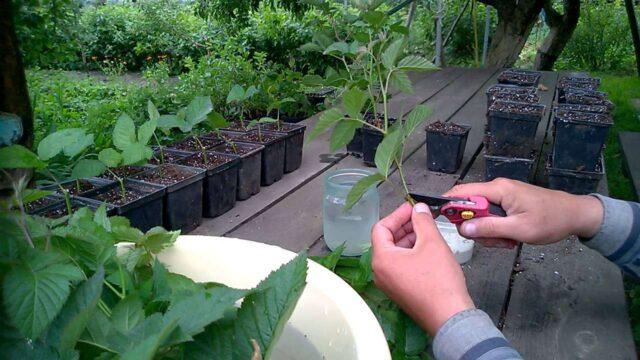
The quality of the seedlings and the harvest in the future depend on the literacy of the procurement of material.
How to cut a blackberry
You can work with different types of propagation cuttings: green, root or lignified. Each of them has a number of features in preparation.
Gardeners fail when:
- The deadlines for the implementation of cuttings were not met, or the manipulation of the propagation of the variety was incorrectly performed.
- The transfer of seedlings into open ground was incorrectly carried out.
- The plant is not properly cared for. Culture is capricious until it is fully strengthened.
Propagation of blackberries by root cuttings
This method is recommended for creeping varieties in which root suckers are poorly developed. You can also use cuttings for breeding upright varieties.
To grow blackberries, you should adhere to the algorithm:
- In late autumn or early spring, dig up an adult shrub as carefully as possible.
- Divide it into pieces or cut off the roots so that they are no closer than 60 cm from the plant.
- Transfer ready-made seedlings to a permanent place or leave for the winter.
To preserve root cuttings, they should be placed in wet sand. Move the container with future shrubs to the basement.

Sprouts can also be stored in wet sawdust in a cool room
Blackberry propagation by green cuttings
In June-July, you can work with green shoots of blackberries. The procedure is recommended during the summer pruning period.
This method is well suited for varieties such as Thornfree, Black Satin, Thornless Logan. Worse take root and poor growth show for the coming spring Smootstam and Dirksen Thornless.
Blackberry propagation by green cuttings is as follows:
- In July, cut the shoots on which several buds are preserved. It should be borne in mind that the upper third part of the shoot is suitable for rooting, but the outer two buds must be removed.
- An ideal stalk should have two leaves, each at the top. Cut off the lower leaf plates.
- Plant the finished seedlings in pots or cups. Fill them with soil mixture, which includes peat and baking powder (sand or perlite).
- Transfer containers to a greenhouse or under plastic wrap to maintain a humid climate. Water the soil in the pots regularly.
- After 25-30 days, when the root system is formed, transfer the blackberries to a permanent place on the site.
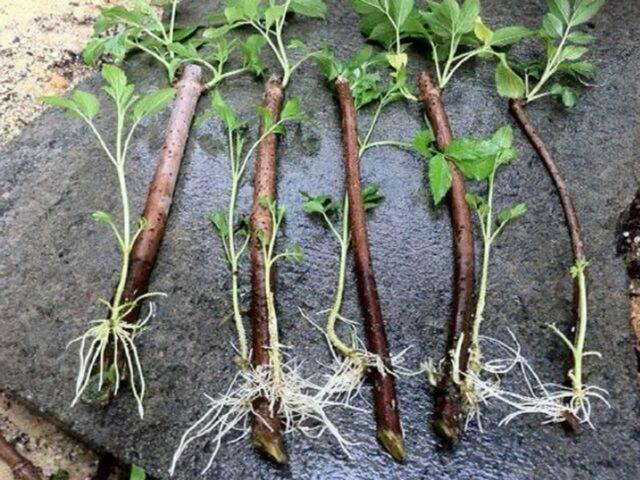
To increase the chances of rooting, it is recommended to treat the shoots with a rooting stimulant: Kornevin or Heteroauxin
Blackberry propagation by lignified cuttings
Gardeners who did not have time to cut the shoots in the summer can prepare everything in the fall.
How to breed blackberries with lignified cuttings:
- Cut branches 20-30 cm in length.
- Dig them in on the site until spring so that they protrude 10 cm above the ground.
- After the snow melts, dig out the cuttings, update the cuts on them and arrange them in rows, keeping a distance of 5-10 cm, and sprinkle them with earth again.
- Water, remove weeds before germination. As soon as they appear, place arches with a film over the seedlings to provide the plant with a high level of moisture.
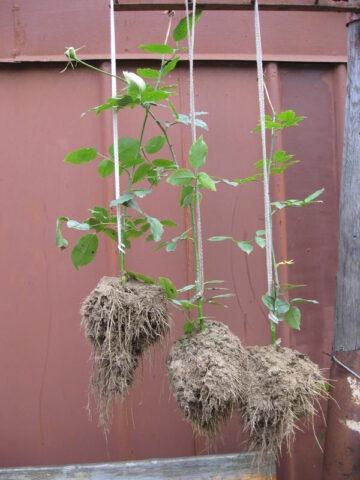
You can plant blackberry cuttings when bushes with 2-3 true leaves grow out of them
There is another way of reproduction by lignified shoots:
- In February-March, cuttings cut in the fall should be placed in the water, top down. Pour the liquid into the container so that it covers the lower kidney. Add water as it evaporates.
- As soon as the roots appear, prepare a separate pot for the cuttings. Pour fertile soil into each of the containers. Move the seedling there.
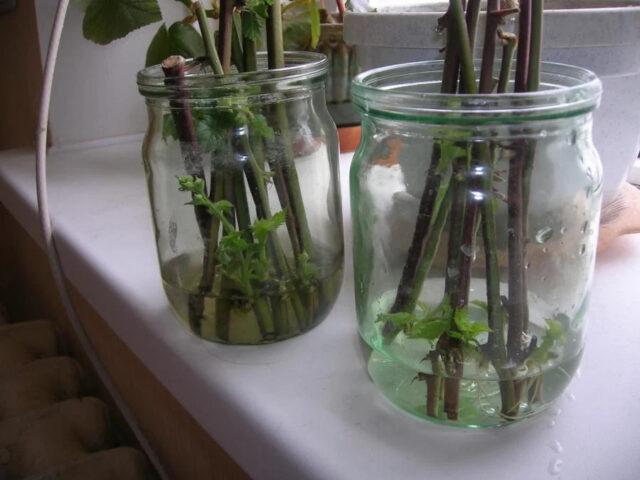
As soon as the roots appear, you can immediately plant the cutting in open ground, and not in a pot, if weather conditions permit
How to plant blackberry cuttings
The knowledge of how to root shoots is not enough. In order for the plants to take root safely after the reproduction procedure, they must be correctly positioned on the site. It is possible to determine whether a blackberry stalk is ready for planting by the degree of development of the rhizome. The lobe should consist of 5-7 branches 10-15 cm long. The length of the above-ground part of the stem is at least 2-3 cm.
In the fall, blackberry cuttings should be rooted before the onset of frost, and in the spring - after the snow melts and the soil warms up.Young plants are placed in pits or furrows, deepening in such a way that the root goes underground by at least 2 cm. Then fill it with soil, making sure to fill all the voids.
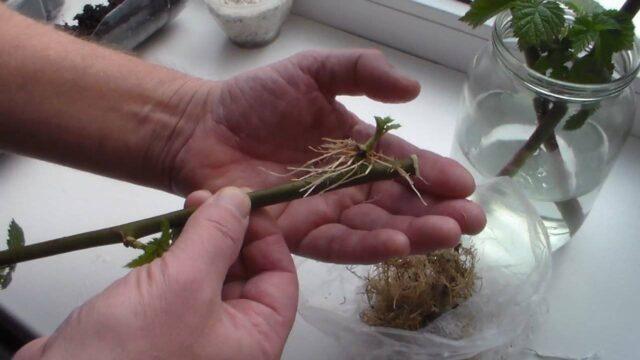
It is not recommended to bend the roots of the blackberry when planting in the hole
Compact the soil around the bed with a bush, applying more force around the periphery and leaving loose soil around the crop trunk so that it gains access to air.
The harvested material can be placed on a plot in the garden without germination. To do this, it is laid in furrows to a depth of 8-10 cm, and then sprinkled with earth. Planting is important to water abundantly.
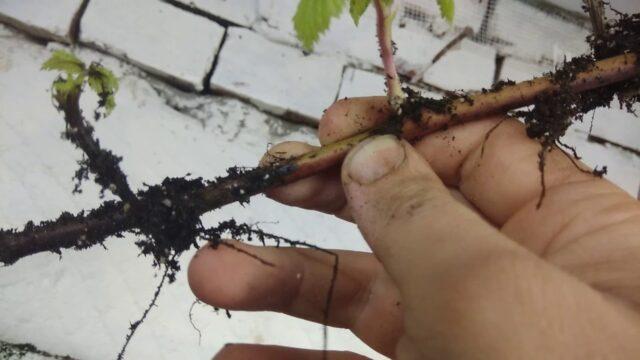
It is necessary to separate cuttings after reproduction only after young bushes with a good root system have formed.
After successful reproduction by cuttings of blackberries in the fall, when the plants have grown stronger and grown, you can decide on the future place of residence of the shrub. Most often, gardeners will plant the plant along the hedge to create a living fence.
The garden bed is best located on a sunny, wind-protected place, on a southern or southeastern slope.
The soil should be fertile with good drainage. Loamy or sandy loam soil, chernozem is preferred. It will not take root on clay soil. The optimum acidity of the soil mixture is 5.7-6.5 pH.
Blackberries do not tolerate soil salinity and excess calcium carbonate.
A suitable planting pit is 40 cm deep and 40 cm in diameter. You can simply prepare a hole whose size is twice the container in which the seedling is located.
To prepare a nutritious soil mixture, you need to mix the following components:
- humus;
- the top layer of earth left after digging a hole;
- sand (if sandy soil prevails on the site);
- potash and phosphorus fertilizing.
From mineral fertilizers, it is recommended to add 30-40 g of superphosphate and 20-30 g of potassium sulfate. From organic dressings, 100-200 g of bone meal or wood ash are suitable.
Mix all the components thoroughly in order to subsequently cover the seedling with the resulting soil mixture during planting.
Work algorithm:
- Place it in a hole, spread out all the roots.
- Deepen the root collar by 2-3 cm.
- Carefully fill the seedling with the prepared soil mixture, compact the earth around the trunk.
- Form a hole for watering, moisten the ground: at least 10 liters for each bush.
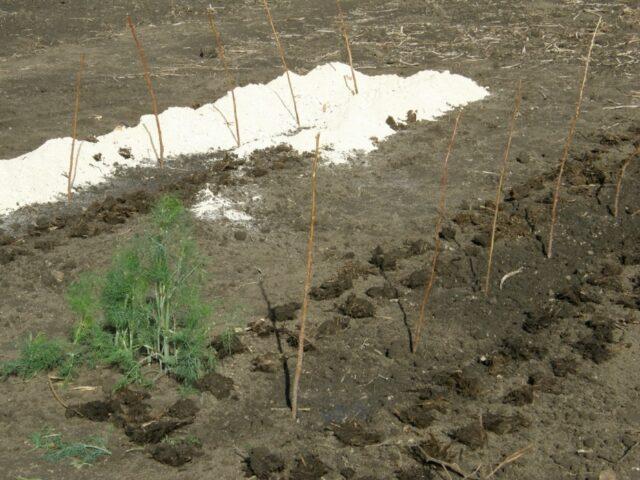
It should be borne in mind that it is important to leave a distance of 1-1.5 m between erect varieties, and between creeping 2.5-3 m
Further care of seedlings
It depends on competent care how the shrub will develop in the future after reproduction. The first year after planting is especially important.
If the stalk has not had time to grow, then it is left without pruning. In the case when a young shrub has grown a green mass, and it was transplanted, it is necessary to shorten the shoots so that 25-30 cm remains before the developed bud.
An obligatory step is mulching. This allows you to retain moisture in the soil, avoid abundant weed growth and the formation of an earthen crust. It is recommended to use sawdust and peat as mulch. They need to be laid in a layer of at least 3-4 cm.
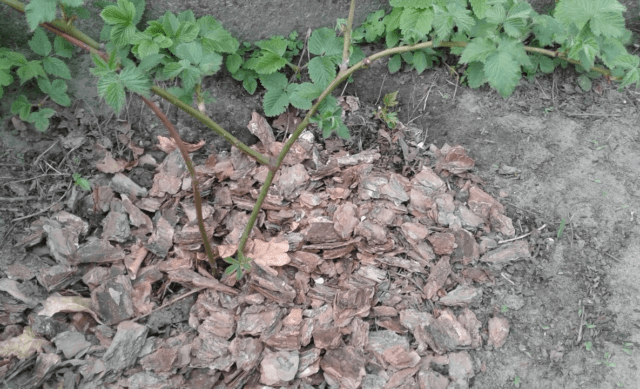
An alternative material that can be used as mulch is bark
It is equally important for the growth of blackberries and watering after propagation by cuttings. Since the root system is not powerful, the soil should be moistened abundantly, but rarely. The shrub is very fond of water during fruiting, so during this period you need to carry out the procedure more often.
Both erect and creeping blackberry varieties need support in the second year after planting. This procedure allows the shrub to form competently, evenly receive the sun's rays, which reduces the risk of developing fungal diseases. You can tie a blackberry to an arch or trellis.
In many regions with cold climates, the plant needs shelter after the breeding procedure. Any means at hand can be used to protect against frost. A layer of mulch will serve as a good cover. You can use peat, sawdust or spruce branches. The use of agrofibre and fabric is widespread. If in winter the temperature drops below -25 ° C, then cover the shrub with a film on top.
The preparation of a crop for winter after successful reproduction includes pruning of plants, their protection from pests. Shoots should be tied up and bent to the ground, and then covered.
Conclusion
Reproduction of blackberries by cuttings is an interesting way to breed a crop on your site. The timing of the breeding procedure is at your own discretion. With the right approach, the gardener can get a strong young shrub next year. For abundant fruiting, the plant should be properly cared for.








